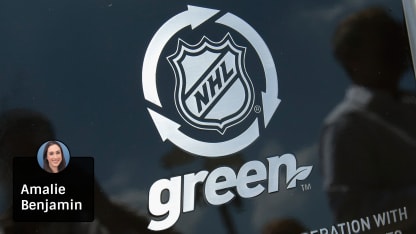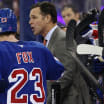It all starts with the ice, and with the outdoors. That's where hockey begins. That's where
NHL Green
begins.
"The reason why the League is focused on environmental sustainability issues is because of two major points: The roots of our sport are tied to playing outdoors and therefore we need cold weather, and the fact that the way we play is on fresh water, frozen fresh water," said Omar Mitchell, NHL vice president for corporate social responsibility.
That's it: The outdoors and the water, the need to keep both habitable, sustainable, usable. That is why the NHL has opted to make NHL Green one of its signature social responsibility platforms, alongside NHL Fights Cancer and Hockey is for Everyone. Green Week will take place March 11-17.
NHL Green focuses on environmental sustainability
League believes clean water, cold temperatures vital to growth of hockey

"Because of those two main concerns, we as a League have realized that this is something that's authentic to us, and it's something that we need to take a leadership stance [on] and be aware of the challenges that that brings to the business of our hockey and the growth of our sport," Mitchell said.
Over the years, the NHL has engaged in a number of initiatives designed toward energy efficiency, toward using and making up for the energy that has been used, combating the League's carbon footprint and finding a way to marry those altruistic goals with added benefit to the NHL's bottom line.
"If you speak to any of our players, a majority of them will say that they've played outdoors, on frozen ponds, on garages that were flooded and frozen," Mitchell said. "There is a uniqueness to the roots of our game that's inherent in playing outside."
There needs to be water, clean water. There needs to be clean air. There needs to be temperatures that allow for outdoor hockey in the north and ball hockey in the south, things that are not now ensured, given the increase in the average world temperatures over the past 15 years.
"Sports has a way of talking about these social issues in a unique way to engage fans," Mitchell said. "We see it with the breaking of the color barrier and the gender barrier. This is just another evolution of how sports can be a way of educating fans about these types of issues."
That means the NHL has recognized that it has to do something, and it has to do something now. It can do something that magnifies its impact over the millions and millions of fans that watch the games and support the clubs and who might see, in the example set by the NHL, something that they can themselves do.
Mitchell ticked off the accomplishments of the NHL since NHL Green started in 2010, including becoming the first sports league to counterbalance its carbon emissions, which it has done for the past three seasons with corporate partner Constellation. That has made the NHL the 26th largest green power purchaser in the United States, the only sports league to make the Environmental Protection Agency's Top 100 list.
Because of the League's commitment to combatting fresh water scarcity, it has contributed to the counterbalancing of more than 50 million gallons of water to dewatered streams across North America, through Gallons for Goals, which sees the NHL restore 1,000 gallons of water for every goal scored in the regular season. As of Friday, that amounted to 5,412,000 gallons.
One of the biggest priorities of the program is the Greener Rinks initiative, which seeks to understand the ecological impact of the approximately 4,800 community rinks in North America in order to help them be more environmentally sustainable and therefore more financially sustainable.
"Why is that important?" Mitchell said. "Because the community rinks are the front lines of our game. That's where kids learn to play our sport."
Through the NHL's Green Week there will be obvious signs throughout the League's arenas, including a gear donation drive of outgrown equipment, recycling that back into the system so that kids no longer have that barrier to entry, also a component of the Greener Rinks initiative, as it relates to lessening the costs of ice time.
Donation nets -- customized goal nets with Plexiglas in front and the net cut out -- will be available for fans to give away their used gear.
But that's not all. There is an amplification process that the NHL has seen through the initiative, through the athletes and the fans and the ways in which even small changes can create big ones.
"I think that when we first started this initiative, our NHL Green platform, it was an awareness that we needed to do more," Mitchell said. "The next steps in the evolution of our program are much more significant. We're trying to influence an entire community rink industry. We're trying to get more athletes to be engaged in this awareness so that they can start to talk about environmental issues in an authentic way.
"I think that as sustainable practices become more engrained in our daily lives, I think the onus will be on sports properties as a whole, including the NHL, to try to give more meaningful access to fans so that they can take that awareness and drive it into their own lives. ... If 72 million fans do their part, we can really have a unique impact."

















